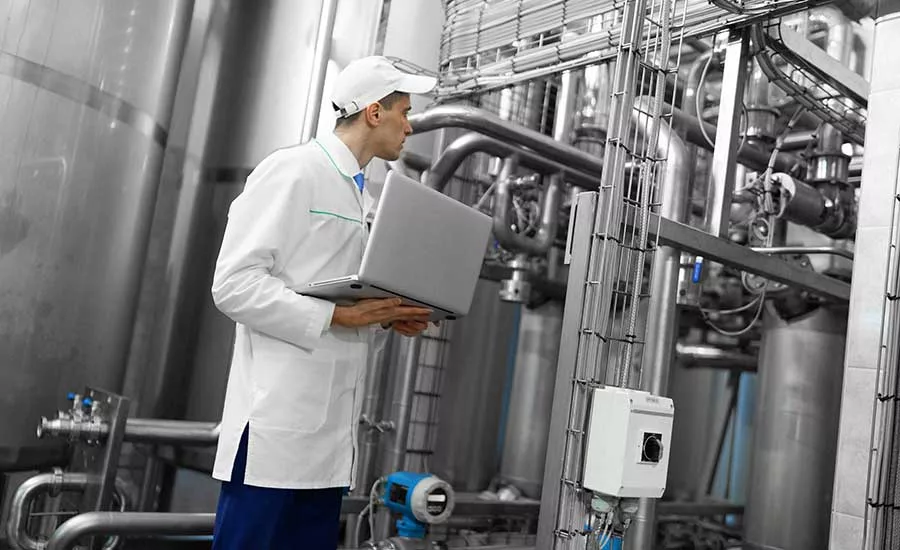Optimize Accuracy of Results with ATP Monitoring

Image credit: Traimak_Ivan/iStock / Getty Images Plus via Getty Images
Adenosine triphosphate (ATP) monitoring for cleanliness is a relatively recent development. Although the science community knew about the reaction between luciferin and luciferase in 1885, it was not until the late 1940s that the proteins were extracted and purified from firefly lanterns. The development of the luminometer that measures very low levels of light, and the subsequent use of bioluminescence to monitor biological contamination, were introduced by Finnish inventor Veikko Tarkkanen in 1975. The monitoring systems that we use today were first offered for commercial application in early 2000.
It took almost a decade for the concept of ATP's use as a marker to measure biological cleanliness to reach the industry and commercial marketplace. Since then, the many technological advancements to the luminometer and chemical developments to the stability of the reactive enzymes and swabbing system have made ATP monitoring systems universally available, practical, and affordable. ATP has seen a meteoric rise in popularity and use, particularly among those of us concerned with "how clean is clean?" ATP monitoring has become increasingly indispensable as a quality control tool. Most of us would not, or could not, do without it.
Its popularity and use have not gone without controversy, however. Many unanswered questions remain relating to how it is applied, what sampling strategy is used, how the samples are taken and, moreover, how the results are interpreted. Repeatability, an important component of quality control testing, is sometimes questionable when the instrument is used by more than one individual and renders completely disparate results. To better understand the complexity and enigma of ATP monitoring, a few considerations to ensure proper use and accuracy of results interpretation are discussed.
Ensuring Accuracy of Results with ATP Monitoring
First, and most importantly, it is essential to understand that ATP monitors detect all materials of plant and animal origin, including bacteria and fungi. Since ATP detects everything, it is a measurement device for "bio-pollution"—affectionately known as a "dirt test." While bacteria and fungi make up part of the ATP that is detected, there is little to no correlation between the total ATP and that portion which makes up the viable microbes. Although there are published ways to estimate the bioburden, with some popular literature stating that 1 femtomole (fmole) of ATP is approximately equivalent to 103 bacterial cells, it is wise to remember that each environment can be considered a separate biosphere, with a characteristic bioload—including no bioload.
For example, when the ATP monitoring system was initially introduced, it was used to provide objective and rapid comparisons between cleaning methodologies. Grape juice that contained no viable organisms on the test surface was used as a surrogate for "heavy" contamination. At that point, it became apparent that ATP monitoring was better utilized as a segue between evaluating visual cleanliness and actual microbiological surface testing. Its utility was to serve as a guide for further action. It was ideal in developing "before" and "after" trending and establishing target patterns for cleaning applications.
There are no ATP standards for cleanliness. Manufacturers' numbers have scant scientific basis for interpretation of data. It is generally accepted, however, that light output in Relative Light Units (RLUs) greater than two to three times the background of a clean surface indicates that the area tested is contaminated with biological material. Little inference can be made on the microbiological contamination. Different environments with different soiling characteristics, differing surface configurations, and different cleaning methodologies will yield different results. Therefore, consider using the ATP monitoring system as its own control for the specific environment in which it is used. Follow up, if necessary, with a microbiological assay to provide a subjective profile for the biosphere sampled. Repeated uniform monitoring with ATP will ultimately provide a usable history of contamination and a guide for its remediation.
Not all ATP systems are alike. Standards have not been established for their uniformity or performance, and no practical standards can be currently developed. There are, however, several industry-sponsored and peer-reviewed studies where some comparisons were made under controlled conditions between and among systems. Most comparisons focus on the strengths of each system, leaving the reader to decide which one will best suit their needs.
Looking for quick answers on food safety topics?
Try Ask FSM, our new smart AI search tool.
Ask FSM →
While the three components remain the same for all—a swab, reagent, and luminometer—each manufacturer differs in some way. For instance, the geometry and makeup of the swabs and the swab/reagent components are not alike. Some of these systems are more temperature- and time-sensitive than others. This can affect accuracy and utility, depending on use. Luminometers are made either with photomultiplier tubes or a single-tube detection. Light output from both is displayed in RLU values. By definition, RLUs have no physical meaning and are often not comparable between the different manufacturer's instruments and their detection capabilities. However, it is a safe assumption that regardless of the system, more photons equals greater light output—and the greater the light output, the greater the bio-pollution. However, the results of each are unique to the system itself.
Choosing an ATP Monitoring System
In considering which ATP monitoring system is most suitable, look for a few relevant markers. These include linearity where the RLU readings are compatible with addition and scaling of fmoles of ATP. In other words, check that there are no "doglegs" on a linear scale from low to high readings. This provides assurance that the readings at either end of the scale are consistent and accurate. While all instruments have different scales, the variability of results is given as a percentage of the mean value of the data set. The system should demonstrate repeatability with controls and be sensitive enough to detect down to 1 fmole ATP.
Other considerations should include ease of use. Simpler is generally better. If the unit is to be used in the field, then the swabs and reagents should be temperature-stable and have a minimum shelf life of one year from date of manufacture. The swab system should not be overly sensitive to light under regular use conditions, and the cell lysing reagent in the swab should rapidly disrupt fungal cells including the more resistant mold spores and yeast cells, as well as bacterial and eukaryotic cells.
Finally, look for a swab system that accommodates a complete sampling program. Specialized swabs are available from the same manufacturer that include ATP monitoring for allergens and water purity.
The Art and Science of Sampling
Regardless of how simple, accurate, sensitive, linear, repeatable, and portable a system is, poor sampling techniques and the failure to use a rational sampling system will invariably yield poor results or, worse, results that are misleading and unusable. Garbage in equals garbage out. Most of us with a long history of using an ATP monitoring system have come to the realization that it is not just about swabbing a surface and recording a result. The art and science of sampling is its measure of success.
To begin, map the facility you are about to monitor into "zones." With labels such as food, heated food, nonfood, power, refuse contact, splash, and unexposed nonfood zone (this comes directly from NSF/ANSI 170: Glossary of Food Equipment Terminology1), it separates the facility by operation and utility. Also, by formally identifying specific areas or zones, it provides a guide to determine where ATP sampling is the most effective, productive, and relevant. It is also prudent to do a few test runs in each zone to ensure the adequacy of the sampling strategy and technique.
Always validate the ATP instrument before use. Most manufacturers provide calibration solutions, or at the least, use distilled water to verify "0" RLU on the meter. Once the instrument is validated, it is also a good idea to test the water used for cleaning before sampling the target environment. For a variety of reasons, the water used in cleaning may contain significant ATP from heterotrophic bacteria that grow in plumbing dead legs, originate from sloughing of biofilm, or come from a surface water source that picks up organic debris before treatment. The amount of ATP in the water used for cleaning can significantly skew the expected results, if not taken into consideration.
If the instrument will be used where it is either warmer or colder relative to the ambient temperature, condition the luminometer by placing it in that environment for about 15 minutes. If the ATP system is taken into the field, place both the luminometer and swabs in an insulated container during transport to avoid temperature extremes.
Every good sampling program begins with a rational sampling strategy, of which there are two: probability and non-probability. If possible, establish a random or stratified probability sampling scheme that will develop a valid database with some statistical accuracy, which is both defensible and repeatable. A good guide for developing such a sampling strategy is MIL-STD-105E: Military Standard—Sampling Procedures and Tables for Inspection by Attributes.2 More refined and updated versions include ANSI/ASQ Z1.4 and Z1.9 Sampling Plan Standards for Quality, available through the American Society for Quality.
Another approach is to follow the guidelines outlined in standard methods, of which there are several sources. The microbial sampling techniques detailed in these standards are acceptable and valid for use with ATP. Judgmental and Snowball sampling should only be used to find problematic areas or as tracebacks. Since finite numerical outcomes in RLUs (or any single sample without statistical relevance) is of little value, a routine non-probability sampling strategy may not yield usable quality control data. Remember, the primary objective of ATP monitoring is to develop before and after trending.
Use a template for sampling, and standardize and codify the sampling technique. This eliminates most of the bias and provides as much repeatability as possible. Templates are available from commercial sources, or are easily fashioned from ATP-inert shirt cardboard or disposable food-grade plastic containers. Two sizes and two configurations seem to meet most sampling needs: a 13-cm2 (2-in2) and a 26-cm2 (4-in2) rectangle and circle cut-out. When swabbing, use a crosshatch technique, diagonally in both directions, and rotate the swab while doing so. Try to be consistent in the number of passes and pressure applied to the swab. To validate the sampling technique that is used, take a second luminometer reading with the same swab. Most importantly, immortalize your sampling program by describing it within a written policy and procedure to ensure continuity of the testing program.
The final bit of information to consider is that each situation in which the monitoring system is used serves as its own control. Easily obtainable higher-order approximations yield usable data, but finite numerical outcomes are infeasible. To ensure consistency of the sampling program and eliminate personal bias, never use the results punitively.
Although this is a but a brief introduction to ATP monitoring, the concepts should provide sufficient information to both enable the reader to select the specific system that is the best fit for their application and guide it in its optimal use and interpretation of findings. We urge everyone who uses this technology to keep up with the literature and refine the sampling process to achieve statistical conformity.
References
- NSF/ANSI. "NSF/ANSI 170-2022: Glossary Of Food Equipment Terminology." https://webstore.ansi.org/standards/nsf/nsfansi1702022.
- U.S. Department of Defense. "MIL-STD-105E: Military Standard—Sampling Procedures and Tables for Inspection by Attributes." May 10, 1989. https://variation.com/wp-content/uploads/standards/mil-std-105e.pdf.
Robert W. Powitz, Ph.D., M.P.H., RS, CF-SP, a forensic sanitarian, is Principal Consultant and Technical Director of Old Saybrook, Connecticut-based R.W. Powitz & Associates, a professional corporation of forensic sanitarians who specialize in environmental and public health litigation support services to law firms, insurance companies, governmental agencies, and industry.








